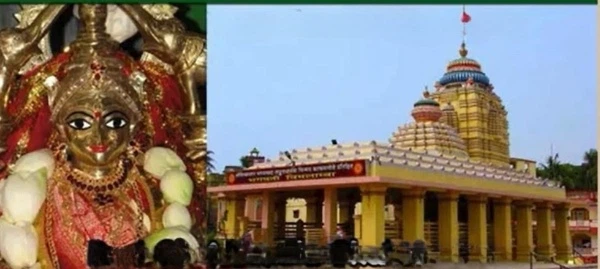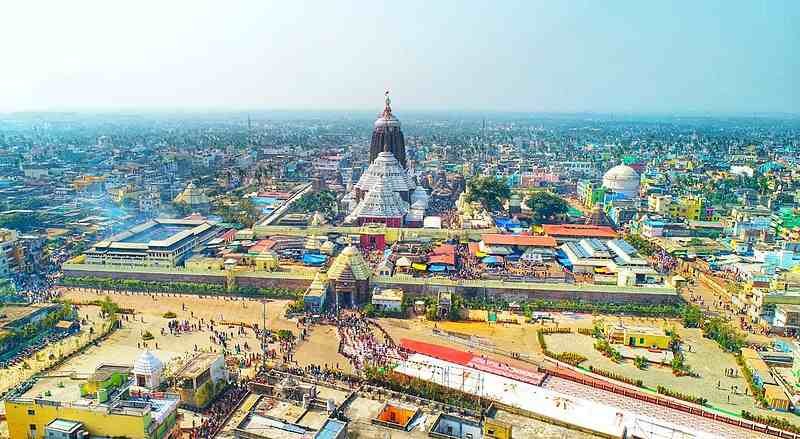The Vimala Temple, also known as the Bimala Temple, is a significant Hindu shrine located within the sacred complex of the Jagannath Temple in Puri, Odisha.
Revered for its spiritual and historical importance, this temple is dedicated to Goddess Vimala, who embodies the pure feminine spirit and is considered a guardian of the Jagannath Temple.
This ancient shrine is not only a significant pilgrimage site but also a marvel of architectural brilliance. Let’s delve into the history, legends, architectural features, festivals, rituals, and nearby attractions that make the Vimala Temple a must-visit destination.

Historical Significance of Vimala Temple in Puri
The Vimala Temple, located within the Jagannath Temple complex in Puri, Odisha, is not only a spiritual haven but also a site steeped in rich history.
Dedicated to Goddess Vimala, this temple is one of the revered Shakti Peethas, where the goddess is worshipped as a manifestation of divine feminine energy.
Origins and Construction
According to historical texts, particularly the Madala Panji, which chronicles events related to the Jagannath Temple, the Vimala Temple was originally constructed in the 6th century CE by Yayati Keshari, a ruler of the Somavanshi dynasty. This dynasty played a crucial role in shaping the cultural and religious landscape of Odisha during that era.
However, architectural analyses suggest that the current structure may have been built in the 9th century CE under the Eastern Ganga dynasty, possibly over the ruins of an earlier temple.
This indicates that while the temple’s origins trace back to the 6th century, it underwent significant reconstruction and renovation, reflecting evolving architectural styles and religious practices over time.
A Sacred Shakti Peetha
The Vimala Temple is considered one of the 51 Shakti Peethas, sacred shrines where the parts of the goddess Sati fell as per Hindu mythology.
According to legend, after the self-immolation of Goddess Sati, Lord Shiva wandered in grief, carrying her charred body. In this process, her body parts fell at various places, which became the Shakti Peethas.
At Vimala Temple, the navel of Goddess Sati is believed to have fallen, making this site particularly sacred to devotees of the Divine Mother.
Role in the Jagannath Temple Complex
The Vimala Temple holds a unique place in Hindu worship, particularly among devotees of Shakti.
It is believed that Goddess Vimala is not only a form of Parvati or Durga but also serves as a tantric consort to Lord Jagannath.
This relationship underscores her role as a guardian of the Jagannath Temple complex, where offerings made to Lord Jagannath are first presented to her.
Only after these offerings are made does food become sanctified as Mahaprasad, highlighting her integral role in temple rituals.
 Historical Context and Legacy
Historical Context and Legacy
The Vimala Temple has been a center for various sects throughout history, particularly those devoted to goddess worship.
It was once a stronghold for the Shri Vidya sect, which emphasizes feminine divinity, until its gradual decline in favor of Vaishnavism. Despite these changes, remnants of its rich past continue to resonate within its walls.
Moreover, notable historical figures such as Adi Shankara, an influential philosopher and saint from the 8th century, are believed to have recognized Vimala as a presiding deity when establishing the Govardhana Matha in Puri.
This connection further solidifies her importance within both spiritual and educational realms of Hinduism.
Renovations and Preservation
Over the centuries, the Vimala Temple has undergone several renovations to preserve its structural integrity and spiritual sanctity.
The temple was notably renovated around 2005 and is maintained by the Archaeological Survey of India. Despite these renovations, the temple retains its ancient charm and continues to be a focal point of Shakta and Tantric worship.
In summary, The historical significance of the Vimala Temple is deeply intertwined with the religious, architectural, and cultural heritage of Odisha.
From its ancient origins and association with the Somavanshi dynasty to its role within the Jagannath Temple complex and influence of Adi Shankaracharya, the Vimala Temple stands as a beacon of divine feminine power and spiritual devotion.
Its enduring legacy continues to attract pilgrims and scholars alike, offering a glimpse into the rich tapestry of India’s ancient traditions.
Architectural Marvel of Vimala Temple in Puri
The Vimala Temple in Puri, Odisha, is a stunning example of ancient Indian architecture, showcasing the intricate and sophisticated design elements characteristic of the Kalinga style. Here is a detailed exploration of its architectural features:
Architectural Style
The Vimala Temple is primarily built in the Deula style, a traditional architectural form prevalent in Odisha. This style is characterized by its distinctive verticality and ornate decorations. The temple is made up of four primary elements.
1. Vimana (Sanctum)
The Vimana stands approximately 60 feet tall and is constructed on a platform that rises about 2 feet from the ground.
It features a square base measuring 15 feet on each side and is adorned with intricate floral designs, scrollwork, and lotus motifs.
The outer wall is divided into five horizontal sections: pabhaga, talajangha, bandhana, upara jangha, and baranda.
Each section showcases elaborate carvings, including figures of deities, floral patterns, and scenes from mythology.
2. Jagamohana (Assembly Hall)
The Jagamohana reaches a height of about 35 feet and also stands on a low platform.
Like the Vimana, it has four vertical divisions: pistha, bada, gandi (sikhara), and mastaka.
The structure’s ground plan is square, measuring 25 feet on each side, with decorative elements such as scrollwork and flower designs enhancing its beauty.
3. Nata Mandapa (Festival Hall)
This component measures 22 feet in height and has a rectangular layout of approximately 35 feet by 18 feet.
Unlike the other structures, the Nata Mandapa’s walls are less ornate but still feature essential architectural divisions similar to those found in the Vimana and Jagamohana.
4. Bhoga Mandapa (Hall of Offerings)
This hall is where offerings are prepared and presented to the deity. The bhoga-mandapa is an essential part of the temple’s daily rituals, ensuring that the offerings are sanctified before being distributed to the devotees.
Decorative Elements
The Vimala Temple is renowned for its elaborate carvings and sculptures that adorn its walls and niches. These include:
Khakhara Mundis: Decorative niches that house various deities.
Erotic Scenes: Carvings depicting amorous couples reflect the temple’s acceptance of life’s dualities.
Floral Motifs: Intricate designs of flowers and creepers enhance the temple’s aesthetic appeal.
Sculptures of Deities: Figures representing various gods and goddesses are intricately carved into the stonework.
The temple’s outer walls are particularly noteworthy for their decorative friezes that depict scenes from Hindu mythology, including royal court scenes and narratives related to divine figures.
The temple is located next to the sacred pond, Rohini Kunda, which is considered holy by the devotees. The presence of the pond adds to the temple’s serene and spiritual ambiance.
In summary, the Vimala Temple stands as an architectural marvel that encapsulates the spiritual essence and artistic heritage of Odisha.
Its intricate design, coupled with historical significance, makes it an essential destination for pilgrims and tourists alike, offering a glimpse into India’s rich cultural tapestry.

Festivals and Rituals
The Vimala Temple is a hub of religious activities, especially during the Durga Puja festival in the Hindu month of Ashvin (October). The festival is celebrated for sixteen days, culminating in Vijayadashami, when the titular Gajapati King of Puri worships the Goddess. Another significant ritual is the offering of Mahaprasad, which is first offered to Vimala before being distributed to devotees.
How to Reach Vimala Temple: A Comprehensive Guide
Puri has good road, rail, and air connectivity. The closest airport is located in Bhubaneswar and is called Biju Patnaik International Airport, which is around 60 kilometers away. Bhubaneswar is connected by regular flights to major cities such as Delhi, Mumbai, and Kolkata.
For those traveling by train, Puri is a major railway junction with direct connections to cities across India. From the railway station, the Vimala Temple is just a short rickshaw or taxi ride away.
Location: Approximately 2 km from Puri city center and easily accessible via auto-rickshaws or taxis.
Vimala Temple Timings: Open daily from 5:00 AM to 10:00 PM.
Duration: Visitors typically spend about 1-2 hours exploring the temple and its surroundings.
Best Time to Visit Vimala Temple
The temple is open throughout the year, but the best time to visit is during the major festivals like Durga Puja and Navaratri when the temple comes alive with celebrations. Additionally, the winter months between October and March offer pleasant weather for exploration.
Accommodation in Puri
Being a major pilgrimage destination, Puri offers a wide range of accommodation options. From budget hotels to luxurious resorts, visitors have plenty of choices. For those seeking a spiritual retreat, several ashrams and dharamshalas provide basic, affordable lodging close to the temple complex.
Nearby Attractions
Visitors to the Vimala Temple can also explore the Jagannath Temple, one of the Char Dham pilgrimage sites, located within the same complex.
The sacred pond Rohini Kunda and the Narasimha Temple are other notable attractions nearby.
Puri’s beautiful beaches and the Konark Sun Temple, a UNESCO World Heritage Site, are also worth visiting.
♣♣ You May Also Like: ⇓
- Remarkable Mayadevi Temple: Heart of Konark’s Hidden Gem
- Mahavinayak Temple, Odisha: A Unique Abode of 5 Deities
- Exclusive Ramachandi Temple, Puri: The Sacred Shakti Pitha
- Lingaraj Temple, Bhubaneswar: Glory of Kalinga Architecture
- Wonderful Budhakhol, Odisha: Heart of the Faith & Miracle
Conclusion
The Vimala Temple in Puri is more than just a sacred shrine; it is a beacon of divine feminine power and a testament to India’s rich cultural and spiritual heritage.
The temple’s historical significance, architectural grandeur, and the profound legends that surround it create an atmosphere of reverence and awe.
Exploring the nearby attractions, from the majestic Jagannath Temple to the serene Puri Beach and the awe-inspiring Konark Sun Temple, further enriches your journey, offering a holistic experience of Odisha’s spiritual and natural beauty.
Each site tells its own story, weaving together a tapestry of devotion, artistry, and history that leaves an indelible mark on the soul.
Whether you seek spiritual solace, historical insights, or simply the joy of discovering new places, the Vimala Temple and its surroundings promise an unforgettable journey.
As you leave, you carry with you not just memories but a deeper connection to the divine and a greater appreciation for the timeless traditions that continue to inspire and uplift.
FAQ:
Is photography allowed in the Vimala temple?
Photography policies can vary from temple to temple. Regarding the Vimala Temple and the Jagannath Temple complex in Puri, photography is generally not allowed inside the temple premises. This restriction is in place to maintain the sanctity and security of the sacred spaces.
However, you can usually take photographs in the outer areas of the temple complex, such as the courtyards and surrounding structures. It’s always a good idea to check with the temple authorities or look for signage regarding photography rules when you visit.

2 thoughts on “Vimala Temple, Puri: A Famous Divine Feminine Power”